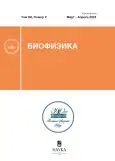Antimicrobial Activity of Metabolite Complexes of Lactobacillus against Pseudomonas aeruginosa
- Authors: Kishilova S.A1, Kolokolova A.Y1, Rozhkova I.V1
-
Affiliations:
- All-Russian Dairy Research Institute
- Issue: Vol 69, No 2 (2024)
- Pages: 324-332
- Section: Articles
- URL: https://journals.rcsi.science/0006-3029/article/view/257582
- DOI: https://doi.org/10.31857/S0006302924020141
- EDN: https://elibrary.ru/OTWPBZ
- ID: 257582
Cite item
Full Text
Abstract
About the authors
S. A Kishilova
All-Russian Dairy Research Institute
Email: s_kishilova@vnimi.org
Moscow, Russia
A. Y Kolokolova
All-Russian Dairy Research InstituteMoscow, Russia
I. V Rozhkova
All-Russian Dairy Research InstituteMoscow, Russia
References
- Андреева С. В., Бахарева Л. И. и Нохрин Д. Ю. Видовой состав микрофлоры ожоговых ран пациентов Челябинского областного ожогового центра. Вестн. Челябинского гос. ун-та, № 7 (298), 58–59 (2013).
- Рожкова И. В., Бегунова А. В., Васина Д. В., Кубанова М. Х., Крупенио Т. В. Шарапченко, С. О. и Габриэлян Н. И. Антагонистическая активность Lactobacillus spp. в отношении госпитальных штаммов Klebsiella spp. Вестн. трансплантологии и искусственных органов, 20 (S1), 180–180 (2018). doi: 10.7868/S05551099118030054
- Кишилова С. А., Терехова Р. И., Рожкова И. В. и Юрова Е.А. Сравнительная оценка антагонистической активности коллекционных лактобацилл в отношении полирезистентных Klebsiella pneumoniae. Вопросы питания, 92 (6), 120–127 (2023). doi: 10.33029/0042-8833-2023-92-6-00-00
- Кручинин А. Г. и Агаркова Е. Ю. Биологически активные пептиды молока: обзор. Пищевая промышленность, № 12, 92–96 (2020). doi: 10.24411/0235-2486-2020-10151
- Savinova O. S., Glazunova O. A., Moiseenko K. V., Begunova A. V., Rozhkova I. V., and Fedorova T. V. Exoproteome analysis of antagonistic interactions between the probiotic bacteria Limosilactobacillus reuteri LR1 and Lacticaseibacillus rhamnosus F and multidrug resistant strain of Кlebsiella pneumonia. Int. J. Mol. Sci., 22 (20), 10999 (2021). doi: 10.3390/ijms222010999
- Zimina M., Babich O., Prosekov A., Sukhikh S., Ivanova S., Shevchenko M., and Noskova S. Overview of global trends in classification, methods of preparation and application of bacteriocins. Antibiotics, 9 (9), 553 (2020). doi: 10.3390/antibiotics9090553
- Стоянова Л. Г. Выделение и идентификация молочнокислых бактерий Lactococcus lactis subsp. lactis с антимикробным действием. Изв. Тимирязев. с.-х. акад., № 5, 41–61 (2017). doi: 10.26897/0021-342X-2017-5-41-61
- Файзуллина Р. А., Самороднова Е. А. и Федотова О. Б. Кисломолочные продукты в питании детей раннего возраста: эволюция от традиционных к функциональным. Рос. вестн. перинатологии и педиатрии, 64 (4), 133–140 (2019). doi: 10.21508/1027-4065-2019-64-4-133-140
- Valdez J. C., Peral M. C., Rachid M., Santana M., and Perdigon G. Interference of Lactobacillus plantarum with Pseudomonas aeruginosa in vitro and in infected burns: the potential use of probiotics in wound treatment. Clin. Microbiol. and Infection, 11 (6), 472–479 (2005). doi: 10.1111/j.1469-0691.2005.01142.х
- Shokri D., Khorasgani M. R., Mohkam M., Fatemi S. M., Ghasemi Y., and Taheri-Kafrani A. The inhibition effect of lactobacilli against growth and biofilm formation of Pseudomonas aeruginosa. Probiotics and Antimicrobial Proteins, 10 (1), 34–42 (2018). doi: 10.1007/s12602-017-9267-9
- Пиядина А. Ю. Воздействие антибактериальных веществ на рост и развитие биопленок клинических изолятов. В кн. Фундаментальные и прикладные исследования: от теории к практике (2018), сс. 245–250.
- Каледина М. В., Федосова А. Н. и Байдина И. А. Антипатогенная активность национальных кисломолочных напитков. Пищевая промышленность, № 10, 72–75 (2019). doi: 10.24411/0235-2486-2019-10163
- Bolla P. A., Carasi P., de los Angeles Bolla M., De Antoni G. L., and de los Angeles Serradell M. Protective effect of a mixture of kefir-isolated lactic acid bacteria and yeasts in a hamster model of Clostridium difficile infection. Anaerobe, 21, 28–33 (2013). doi: 10.1016/j.anaerobe.2013.03.010
- Garrote G. L., Abraham A. G., and De Antoni G. L. Inhibitory power of kefir: the role of organic acids. J. Food Protection, 63 (3), 364–369 (2000). doi: 10.4315/0362-028X-63.3.364
- МУ 2.3.2789-10 «Продовольственное сырье и пищевые продукты. Методические указания по санитарно-эпидемиологической оценке безопасности и функционального потенциала пробиотических микроорганизмов, используемых для производства пищевых продуктов».
- МУК 4.2.1890-04 «Определение чувствительности микроорганизмов к антибактериальным препаратам».
- Pang Z., Raudonis R., Glick B. R., Lin T. J., and Cheng Z. Antibiotic resistance in Pseudomonas aeruginosa: mechanisms and alternative therapeutic strategies. Biotechnol. Adv., 37 (1), 177–192 (2019). doi: 10.1016/j.biotechadv.2018.11.013
- Рыбальченко О. В. и Бондаренко В. М. Образование биопленок симбионтными представителями микробиоты кишечника как форма существования бактерий. Вестн. Санкт-Петербургского университета. Медицина, № 1, 179–186 (2013).
- Сухина М. А., Шелыгин Ю. А., Жуховицкий В. Г., Фролов С. А., Кашников В. Н., Веселов А. В. и Чистякова Д. А. Перспективы использования антагонистической активности лактобацилл для подавления роста Clostridium (Clostridioides) difficile. Эксперим. клинич. гастроэнтерология, № 12 (160), 19–24 (2018). doi: 10.31146/1682-8658-есg-160-12-19-24
- Calasso M., Di Cagno R., De Angelis M., Campanella D., Minervini F., and Gobbetti M. Effects of the peptide pheromone plantaricin A and cocultivation with Lactobacillus sanfranciscensis DPPMA174 on the exoproteome and the adhesion capacity of Lactobacillus plantarum DC400. Appl. Environ. Microbiol., 79 (8), 2657–2669 (2013). doi: 10.1128/AEM.03625-12
- Агаркова Е. Ю. и Кручинин А. Г. Ферментативная конверсия как способ получения биологически активных пептидов. Вестн. Мурманского гос. техн. ун-та, 21 (3), 412–419 (2018). doi: 10.21443/1560-9278-2018-21-3-412-419
Supplementary files










